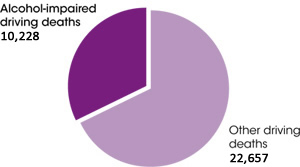More women are drinking and driving
Traditionally, men have been seen as the riskier gender when it comes to car insurance. However, a disturbing new trend shows that DUI rates among men are rising while among women they are rising rapidly. Men are still more likely to get a DUI but new research shows that more and more women are drinking and driving.
More women are drinking and driving: A growing trend
Researchers recently convened in Washington to present evidence that drinking and driving is a growing problem among women. DUI arrests among women have increased almost 30% from 1998 to 2007, according to the Traffic Injury Research Foundation.
More women are drinking and driving: What is the cause?
Many experts have hypothesized the reason that more women are drinking and driving. Binge drinking (consuming more than four drinks in a sitting for women and five for men) rates are also rising for women. Some think that today’s women have to deal with more stress than their predecessors. More equality in the workplace combined with the same amount of home life duties may be causing more women to turn to alcohol. Because of the recession, women’s incomes have become more important because so many men have lost their jobs. Meanwhile, women are still responsible for most of the child-rearing responsibilities.
In addition, there are more female drivers on the roads today. In fact, female drivers outnumber male drivers. So part of the cause may just be that more women are drinking and driving because more women are driving.
Another theory points to the increase in the female-directed marketing campaigns for marketing.
In addition, women may not realize that alcohol tends have a greater effect than it does on men. The same number of drinks may put a woman over the legal limit while the man is still able to drive.
More women are drinking and driving: Who’s at risk?
Studies show that women who drink and drive tend to share similar characteristics. They tend to be unmarried and have less steady employment compared to men who drink and drive. Women who drink and drive were also more likely to have a primary problem with drugs like cocaine and/or a psychological problem like depression and bipolar disorder. Also, young women wanting to fit in, young mothers after the birth of a baby, and empty nesters drink and drive more often.
Women are also more likely to have children in the car, so more women drinking and driving also means more children at risk of fatal car accidents.
More women are drinking and driving: Getting help
Unfortunately women with drinking problems are much less likely to seek help than their male counterparts. Unlike men, women tend to drink alone and at home, which enables them to hide a problem from friends and family. When women do seek treatment, it is usually after something catastrophic has already happened. Women also tend to have most of the responsibility in raising children, so they are less likely to be able to go to inpatient treatment centers.
Sources:
http://healthland.time.com/2013/01/24/why-women-drink-and-drive/
http://www.nbcnews.com/id/32321637/ns/health-addictions/t/women-drinking-more-duis-experts-say/



